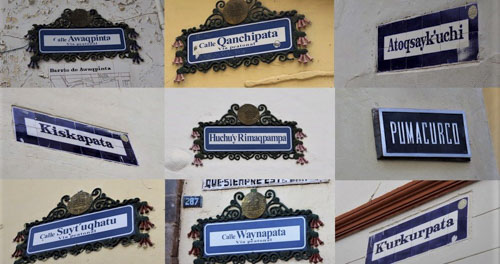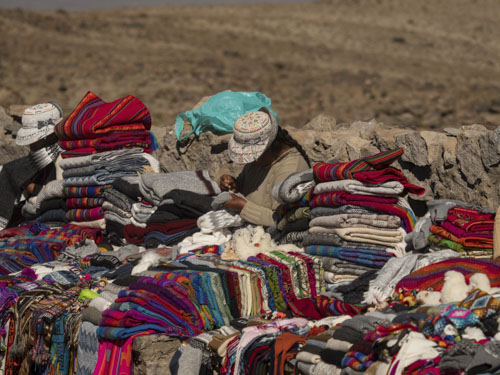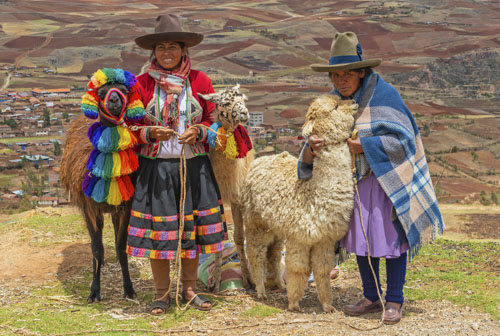A Peruvian woman working with alpaca wool
By Lauren-Rose Stunell
Not So at Risk
As someone with a deep passion for Indigenous languages and language learning, one thing about the Quechua language struck me as unusual and outstanding — it is not only surviving, but thriving! Even “Huttese,” the language of the Hutts in Star Wars, is based on the phonology of Quechua!
For many of the Indigenous languages of North America, we can see a steady decline in the number of speakers. Some Indigenous languages — such as Michif, Cree, and Anishinaabemowin — are in danger of extinction, requiring efforts to help them survive. Quechua, a South American Indigenous language, currently has over 7.5 million speakers. How is it possible that this Indigenous language is thriving after colonization while other Indigenous languages across the globe are fighting for survival?

Quechua is believed to have been adopted during the time of the Incas, which only lasted about 100 years. This sparks further curiosity as to how this language bloomed into one of the strongest, most-spoken Indigenous languages in the world. Despite Spanish colonization and efforts to eradicate the people who spoke it, the Quechua language and traditions still flourish today. Quechua is an official language in Peru and Bolivia, which undoubtedly aids in its preservation. The Quechua people of South America have continued to pass down their traditions, history, and language from generation to generation.
Hello! Napaykullayki!
Quechua is a unique language spoken in many South American countries spanning the regions of Peru, Bolivia, Ecuador, Argentina, Colombia, and Chile. The language can most commonly be heard in the Peruvian Andes. Much like the other Indigenous languages in CASLT’s Discovering Languages series, Quechua is an oral language first written down by Spanish colonizers.
Bright Colours and a Bright Future
The Quechua people are known for their traditionally bright and diverse clothing and textiles, and they share an equally colourful history. The Quechua are well known for their strong cultural identity, their traditional practices, and their resilience in ongoing and historical challenges and colonial oppression.

Cusco, the capital of the Inca Empire, is also a bright and colourful city. Located in the southeastern part of Peru, it has a bustling and vibrant culture. The city is filled with colourful architecture, with traditional Inca designs and artisanship. People wear brightly coloured clothing and the local markets are filled with many such textiles. The city is surrounded by the beautiful landscape of the Sacred Valley of the Incas.

The Quechua language flows through the area. It can be found on road signs and official government documents and heard widely in conversation. Many American universities, such as the University of Pennsylvania, offer Quechua as an additional language, which spreads its fluency and history to more people to preserve it for future generations.
In Canada, over 60,000 students, mostly in British Columbia, are currently learning Indigenous languages in elementary and secondary schools. Many Canadian universities also offer Indigenous language programs or degrees, including First Nations University of Canada, the University of British Columbia, the University of Victoria, Simon Fraser University, the University of Regina, and the University of Winnipeg. Thus Western Canada, at least, has begun to make good on the Truth and Reconciliation Commission’s calls to action on language and culture (#13 to #17) and is beginning to preserve our own Indigenous languages for the future generations of Turtle Island. However, many languages are still at risk, so there is more work to do.
Learn the Rainbow . . . in Quechua! Incorporating the Neurolinguistic Approach in the Classroom
Learning Objectives
At the end of this lesson, teachers and educators will be able to incorporate the neurolinguistic approach to encourage their learners to speak in their target language. Modelling sentence structure while also exploring the Quechua language is central to the lesson.
Students will develop a foundational understanding of the Quechua people and their language. They will be able to identify the flag of Cusco and explain its deep meaning and symbolism. They will have a basic understanding of South American geography, the location of the Peruvian Andes, and how the Quechua language spans many countries.
Introduction to the Lesson
Introduce the activity by showing students the flag of Cusco. Explain that Cusco (also spelled Cuzco) is the capital of the Incan people, now a city in the Peruvian Andes. With a foundational understanding of the bright colours of Peru, students may begin to understand why the flag is so many colours. Help students expand their understanding of the adjective “colourful.” What does “colourful” mean in terms of being a vibrant community full of life and diversity?
Additional Context
You may choose to share this paragraph from the blog above, which outlines the city of Cusco in more detail:
Cusco, the capital of the Inca Empire, is also a bright and colourful city. Located in the southeastern part of Peru, it has a bustling and vibrant culture. The city is filled with colourful architecture, with traditional Inca designs and artisanship. People wear brightly coloured clothing and the local markets are filled with many such textiles. The city is surrounded by the beautiful landscape of the Sacred Valley of the Incas.
This UNESCO World Heritage video also provides stunning visuals and information designed for elementary to secondary learners.
Activity Sequence
- Introduce the lesson by asking students what their favourite colour is! This incorporates the neurolinguistic approach and encourages learners to speak and share in their target language. You can enhance the questions by asking students the words for colours in their home languages.
- Introduce the Quechua Color Words webpage. The class can work together to practice identifying the colours in the Quechua language and sharing the names of colours in the classroom target language and/or students’ home languages.
- Encourage students to share their favourite colour with their new vocabulary. Students can use the sentence starter in their target language “My favourite colour is . . .” and replace the colour word with the Quechua word. The teacher may pose questions such as “What is her favourite colour?” or “What are their favourite colours?” to encourage students to use different verb conjugations.
- In primary grades, end the lesson by asking students to write down their sentences, incorporating their new vocabulary, to conclude the literacy loop and encourage an exit slip.
Extending the Activity for Older Audiences
For older audiences, the activity can be enhanced by incorporating other unique parts of Quechua culture and community. Students can watch this “Quechua People, Culture, & Language” video together to gain a deeper understanding of the Quechua language and take notes or use sketchnote to document their learning and facts from the video.
Class activities using the video:
- Create a Venn diagram comparing and contrasting the Quechua culture with the students’ own cultures and home languages.
- Create an infographic highlighting the vibrancy of the Quechua culture, especially that of Peru.
- Write a travel article identifying sights to see and where to notice the Quechua language in the Peruvian Andes.
- Brainstorm questions for interviewing a Quechua speaker.
- Create an infographic on the importance of preserving Indigenous languages, both in and outside of Canada.




